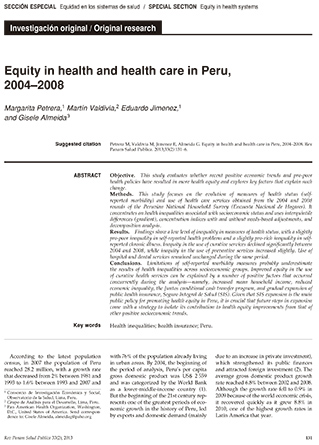Equity in health and health care in Peru, 2004-2008
| Year | : | 2013 |
|---|---|---|
| Author/s | : | Margarita Petrera, Martin Valdivia, Eduardo Jiménez, Gisele Almeida |
| Area/s | : | State reform and public institutions, Health and nutrition |
[2013] PETRERA, Margarita; VALDIVIA, Martín; JIMENEZ, Eduardo y Gisele ALMEIDA. “Equity in health and health care in Peru, 2004-2008”. Pan American Journal of Public Health. Washington, D.C., Vol. 33, No. 2, pp. 131-136.
Objective. This study evaluates whether recent positive economic trends and pro-poor health policies have resulted in more health equity and explores key factors that explain such change.
Methods. This study focuses on the evolution of measures of health status (selfreported morbidity) and use of health care services obtained from the 2004 and 2008 rounds of the Peruvian National Household Survey (Encuesta Nacional de Hogares). It concentrates on health inequalities associated with socioeconomic status and uses interquintile differences (gradient), concentration indices with and without needs-based adjustments, and decomposition analysis.
Results. Findings show a low level of inequality in measures of health status, with a slightly pro-poor inequality in self-reported health problems and a slightly pro-rich inequality in selfreported chronic illness. Inequity in the use of curative services declined significantly between 2004 and 2008, while inequity in the use of preventive services increased slightly. Use of hospital and dental services remained unchanged during the same period.
Conclusions. Limitations of self-reported morbidity measures probably underestimate the results of health inequalities across socioeconomic groups. Improved equity in the use of curative health services can be explained by a number of positive factors that occurred concurrently during the analysis-namely, increased mean household income, reduced economic inequality, the Juntos conditional cash transfer program, and gradual expansion of public health insurance, Seguro Integral de Salud (SIS). Given that SIS expansion is the main public policy for promoting health equity in Peru, it is crucial that future steps in expansion come with a strategy to isolate its contribution to health equity improvements from that of other positive socioeconomic trends.






